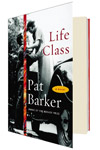In Life Class, Pat Barker’s eleventh novel, the British author returns to the troubling imagery of World War I. It takes a while for Barker to reach the front—the first half of the novel is set in and around London’s Slade School of Fine Art. Here, Paul Tarrant (working-class and moody) and Elinor Brooke (bourgeois and wily) attend life-drawing classes, drink themselves silly in the Café Royal, and seduce other people despite their obvious attraction to each other. It is the spring of 1914 and Elinor and Paul seem much like today’s artsy students: keen to consider gender and class inequality, preoccupied with booze, driven, at times, to work hard on their art. In Life Class there’s just more horse dung in the streets.
This is a lusty tale, and Barker is careful not to let historical research derail momentum. The narrative buoyancy is also due to Barker’s sense of sight, fitting for a story about the painter’s gaze: light is “lemony”; eyes are “the colour of infected phlegm”; sunbathing men are “starfish shapes.” There are lively verbs here, too: a path is “thronged with weeds”; dust motes “seethed in a shaft of sunlight.” Barker finds motion and vigor, despite the looming backdrop of a war’s horrors. She is intent on making us see.
Once Paul volunteers for the Belgian Red Cross, these horrors move to the foreground. In letters to Elinor, Paul describes a man “cradling his intestines in his arms”; shrapnel which “severed the penis at the base”; a dead soldier “so badly decomposed… he came apart in our hands.” We see the dark levity of the operating theater, where doctors are “wearing red gowns, or so it seems… flirting with the younger nurses, unconscious of the stench of blood.” One “notices an amputated leg that hasn’t been cleared away… and, in a sudden burst of fury, kicks it across the floor.” This might seem like M.A.S.H. minus Klinger, but Barker’s focus serves a clear didactic purpose. How can art continue in a time of war? It can persist, the novel suggests, in the precise and vivid rendering of war’s effects. In Ypres, Paul’s new model is a wounded soldier, portrayed in one painting as a “blob of tortured nerves.” Despite the fact that Elinor and her ilk deem this subject matter inappropriate, the argument that civilians should have access to such images is compelling. This appears to be Barker’s hope for art in all periods of war: “The men’s life class limps on” at the Slade because it must. Paul asks, “Do people change that much?” And is the art of another time “relevant to the modern world”? “No” and “yes,” Barker implies in response.
Before Ypres, Paul’s teacher is the “real-life” Henry Tonks. (A contemporary of John Singer Sargent’s, Tonks was a surgeon and an official war artist in 1918.) In the acknowledgments, Barker describes Tonks’s “portraits of facially mutilated men” as “among the most moving images to have come out of any war. They were not exhibited in his lifetime, nor for many years afterwards.” If Barker’s project is to exhibit the casualties, she succeeds again in Life Class.“It’s like turning a key in a lock,” says Elinor, of absentee student painters who decide to return to the Slade. “If it turns you forget about it. If it doesn’t you go on rattling away.” In a time when images of returning military coffins are banned on U.S. television and the reportage we do have is couched in lingo meant to distance or assuage rather than illustrate, I think we need another war novel fromBarker. Viewers can’t see “3,860,” the number of U.S. dead in the Iraq War as of this writing, which makes Barker’s subject matter quite relevant, sadly. I hope the author continues to rattle loudly.





